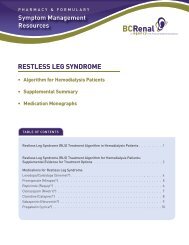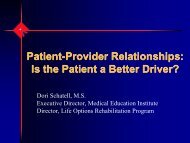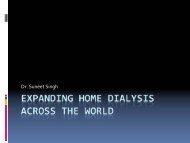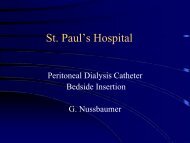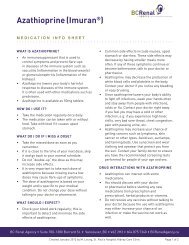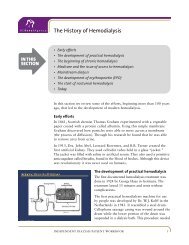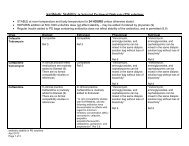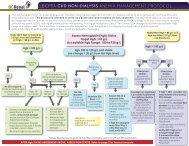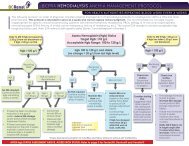Endotoxin Testing of Dialysis Water - BC Renal Agency
Endotoxin Testing of Dialysis Water - BC Renal Agency
Endotoxin Testing of Dialysis Water - BC Renal Agency
You also want an ePaper? Increase the reach of your titles
YUMPU automatically turns print PDFs into web optimized ePapers that Google loves.
<strong>Dialysis</strong> water<br />
Disinfection<br />
<strong>Endotoxin</strong><br />
<strong>Endotoxin</strong> Units (EU)<br />
Hemodialysis<br />
HPC<br />
LAL<br />
LAL test<br />
Microbial<br />
Microbial contamination<br />
as dialysis fluid, dialyzing fluid, or dialysis solution.<br />
<strong>Water</strong> that has been treated to meet the requirements <strong>of</strong> the CSA-ISO<br />
standards and which is suitable for use in hemodialysis applications,<br />
including the preparation <strong>of</strong> dialysis fluid, reprocessing <strong>of</strong> dialysate,<br />
preparation <strong>of</strong> concentrates and preparation <strong>of</strong> substitution fluid for online<br />
convective therapies.<br />
Destruction <strong>of</strong> pathogenic and other kinds <strong>of</strong> microorganisms by thermal or<br />
chemical means.<br />
Major component <strong>of</strong> the outer cell wall <strong>of</strong> gram-negative bacteria. (See also<br />
pyrogen.)<br />
Units assayed by the LAL test when testing for endotoxins.<br />
Form <strong>of</strong> renal replacement therapy in which waste solutes are removed<br />
primarily by diffusion from blood flowing on one side <strong>of</strong> a membrane into<br />
dialysis fluid flowing on the other side.<br />
Heterotrophic Plate Count.<br />
Limulus amoebocye lysate.<br />
Assay used to detect pyrogens and measure endotoxin levels.<br />
Referring to microscopic organisms, such as bacteria, fungi, and algae.<br />
Contamination with any form <strong>of</strong> microorganism (e.g., bacteria, yeast, fungi,<br />
and algae) or with the by-products <strong>of</strong> living or dead organisms such as<br />
endotoxins, exotoxins and cyanobacterial toxins (derived from blue-green<br />
algae).<br />
Pyrogen A substance that can cause fever (elevation <strong>of</strong> body temperature above 37.8<br />
°C). Symptoms <strong>of</strong> a pyrogenic reaction may include chills, rigours, nausea,<br />
vomiting, and hypotension. (See also endotoxin.)<br />
RO<br />
Reverse osmosis.<br />
Disclaimer: The procedure steps may not depict actual sequence <strong>of</strong> events. Site-specific considerations may be<br />
made when applying the following procedures and protocols.<br />
3.0 EQUIPMENT<br />
<br />
<br />
<br />
<br />
4.0 PROCEDURE<br />
LAL Sample Kit (to be determined)<br />
Alcohol swabs<br />
Gloves<br />
<strong>Endotoxin</strong> <strong>Testing</strong> <strong>of</strong> <strong>Dialysis</strong> <strong>Water</strong> Log Sheet<br />
4.1 <strong>Dialysis</strong> water sample collection.<br />
Note: Samples should always be collected before cleaning/disinfection.<br />
4.1.1 Collect the sample from a point in the distal segment <strong>of</strong> the loop, immediately prior to<br />
where water returns to the RO, or immediately prior to where the water re-enters the<br />
storage tank, if one is present.<br />
For portable ROs, collect the sample from the outlet <strong>of</strong> the portable RO.<br />
4.1.2 The sample taps should be opened and the water should be allowed to run for at least 60<br />
seconds before a sample is collected in a LAL sampling unit.




